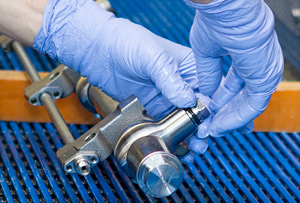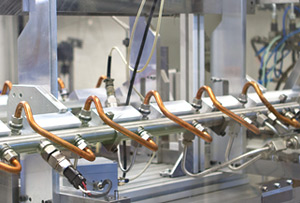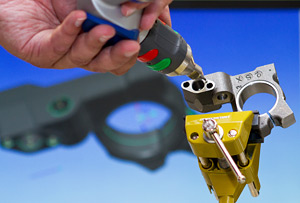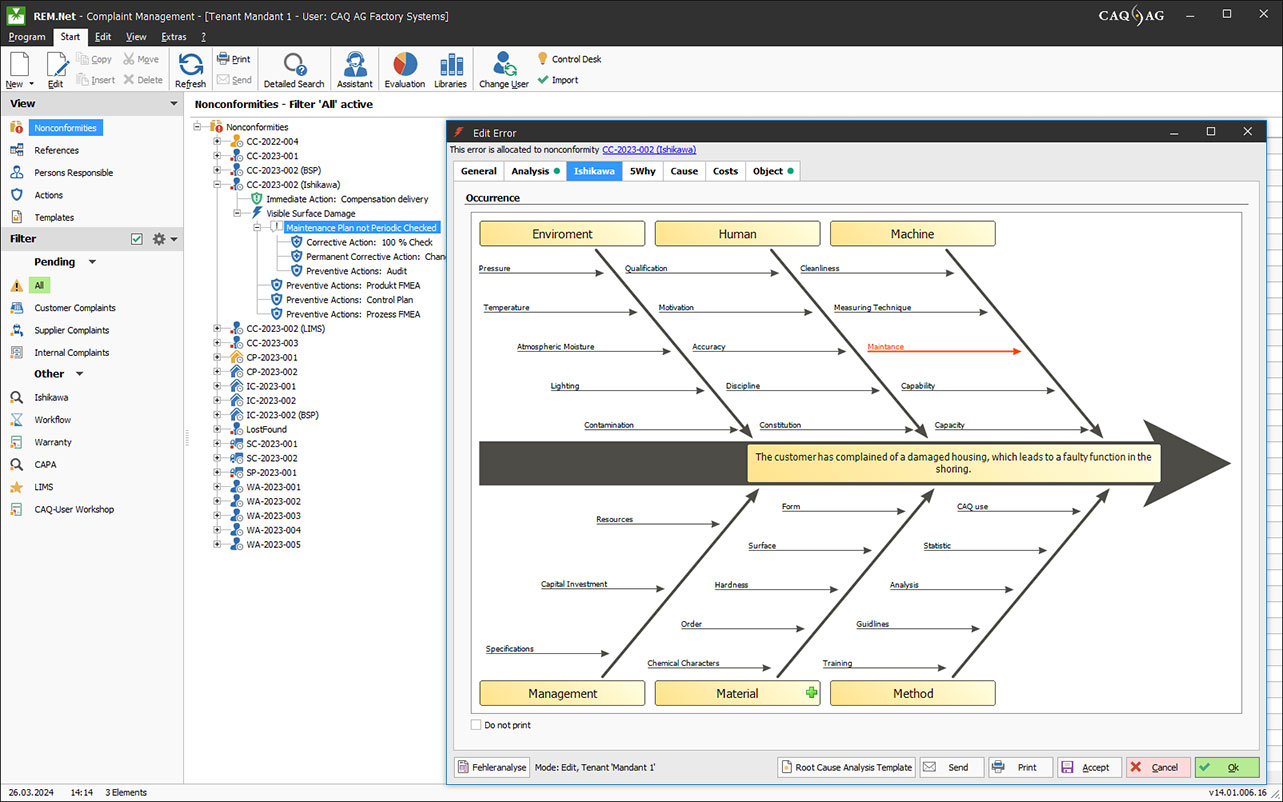
CAQ-Software at Peter Fuchs: Diesel Power – Quality for Common Rail Systems
Modern diesel fuelled cars in the uppermost power segment produce between 300 and 500 HP, and the strongest truck that is manufactured in series produces a whopping 750 HP. These are pretty impressive figures. Those numbers do, however, appear a little unspectacular when compared with the values of large diesel engines in construction vehicles, ships, trains, and industrial power generators. The engines for which Peter Fuchs Technology Group manufactures components require not only the adding of a zero but also the doubling of the sum: their output ranges from 1000 to 6000 HP and well of 10,000 HP in maritime applications.
 Assembly of a common rail system
Assembly of a common rail system
The comparison of cylinder numbers also shows that these large diesel engines play in a different league. Whereas in a car today you can be happy if you get your hands on a six-cylinder, the engines that Fuchs Diesel produces components for generally start with a V8 and the span only ends at a V20.
High Pressure Components for Large Diesel Engines
The fact that the cylinders of these engines must somehow be fed with fuel, brings us right to the key product of Fuchs Diesel: customer-specific common-rail solutions for large diesel engines. In three locations throughout Switzerland the company produces all components that are mounted between the high-pressure pump and the injectors of large diesel engines.
A 25 Ton Living Room
Let’s get back to our initial comparison with standard car engines. The V12 engine in the most powerful diesel car today draws its 500 HP and 1000 NM from an impressive 6 litres of engine displacement. The customers of Fuchs Diesel, however, are located more between 140 and 235 litres of engine displacement. These large diesels thereby grow to 6 meters in length and 3 meters in height – roughly the size of a living room. A 25 ton living room, that is.
Large and Precise
 Pulsation test with pressure monitoring
Pulsation test with pressure monitoring
When one thinks about the term “precision”, the images that one will most likely think of are watchmakers, semiconductors, or micro-chirurgical instruments – a 25 ton diesel engine is, quite frankly, not the first thing that springs to mind. But if one considers the physical forces that are involved, it rapidly becomes apparent, that the subsequent operative readiness of the individual components relies on a significant degree of precision during the entire manufacturing process. In order to explain this further, here’s a short comparison of household pressure levels and the pressures involved at Fuchs Diesel. Whereas a car tyre must handle between 2 and 3 bar of pressure and a bike tyre is inflated to up to 8 bar, the diesel fuel at Fuchs Diesel rushes through the common-rail injection system at 3600 bar and more.
Under Pressure
Precision, pressure, performance, and durability even in the most hostile environments are all aspects that require one irrefutable factor: the highest possible level of quality. Within the more than 20 years of experience in the design and assembly of components and systems for high pressure pumps, a diverse range of testing methods have been implemented at Fuchs Diesel. These include pressure tests, pulsation tests, and measurements of fluid flow at high and low pressure levels. The highly specialized testing and production techniques at Fuchs Diesel – including the so-called autofrettage at up to 15,000 bar – obviously also bring about great challenges for the quality management in the company.
An Adaptable Solution for Innovative Products
In order to consolidate the quality management matters in the company and administrate the various testing and measurement procedures in one system, Fuchs Diesel conducted exhaustive market research in the year 2000. After said research, they decided to implement the CAQ.Net Quality Management Software by CAQ AG Factory Systems. They started by introducing the modules for gauge management, SPC, incoming/outgoing goods inspections, quality planning & inspection, as well as initial sample test reporting. This initial basis grew steadily over the years and Fuchs Diesel today commands a comprehensive software solution that facilitates sophisticated quality management at the highest possible level.
Central Quality Control
 Testing laboratory for dimension measurements
Testing laboratory for dimension measurements
Step-by-step the modules for complaint management, document management, and audit management were introduced. In order to monitor the execution of actions, the company implemented the so-called JobControl.Net module. This program facilitates comprehensive action and escalation management throughout all departments of the company and ensures that every job gets done. In order to be able to ensure consistent quality throughout all products and processes at Fuchs Diesel, it is important that the company always has an overview of the relevant information. That is why they implemented QDrive.Net – CAQ.Net’s central quality control module. Whether FMEAs, complaints or incoming goods inspections – QDrive.Net displays all occurrences of selected data in the modules and highlights the individual correlations in one powerful user interface. It thereby allows users to not only view the data, but to directly access programs and process-relevant information at the push of a button.
ERP-Linkage
The bidirectional data exchange between CAQ.Net and the Navision ERP-System is executed via a direct interface. Master data, order data, and complaints can thereby be exchanged seamlessly. The direct linkage is also of importance with regard to the various production facilities, as their individual IT-infrastructures can also communicate directly with one another.
Tracking Down Faults
Even though Fuchs Diesel conducts highly efficient proactive fault-avoidance via CAQ.Net’s FMEA, FAI, and APQP Software solutions, defects and complaints can never be fully avoided. In order to figure out the root causes for said defects or complaints, the company for instance uses the 5-Why and Ishikawa functions of CAQ.Net. If any type of irregularity should occur at the customer, the root causes can be detected via these techniques. The 5-Why method, developed by Toyota, uses a simple yet effective question asking technique in order to find root causes. Repeatedly asking the question of “Why?” peels away individual causes bit by bit and eventually exposes the root cause of a problem.
 Ishikawa Diagram in REM.Net
Ishikawa Diagram in REM.Net
The Ishikawa Diagram
The Ishikawa Diagram works in a similar manner. It allows the user to consolidate all possible problem causes and interdependencies in a clearly structured fishbone diagram. The influencing variables are subdivided into primary and secondary causes which all point towards the main problem or potential for improvement. The individual arrows each stand for a contributing factor to a cause or improvement. Any type or number of primary causes can be applied. These are then addressed step by step, thereby allowing valuable information to come to the fore. The analysis of the various influence factors via the Ishikawa Diagram often reveals connections that no one would have thought of initially.
Ready for Tomorrow
The next step of the system expansion at Fuchs Diesel will consist of the CAQ.Net training management module. This module allows the company to manage their highly specialized employee trainings and qualifications in one easily usable interface. The proactive maintenance module will also be enhanced to include all machines in the various production facilities. Of course, the new modules seamlessly merge with the rest of Fuchs Diesel’s QDrive.Net system environment. All of this means that the central quality control can provide Fuchs Diesel with even more support during the production of high-pressure components for the who’s who of international large diesel engine manufacturers.
Additional Links